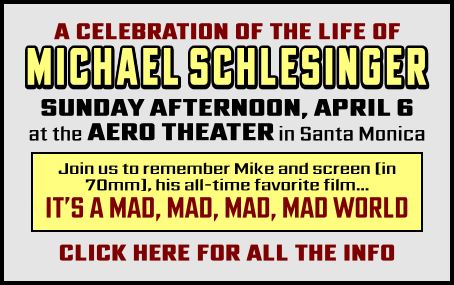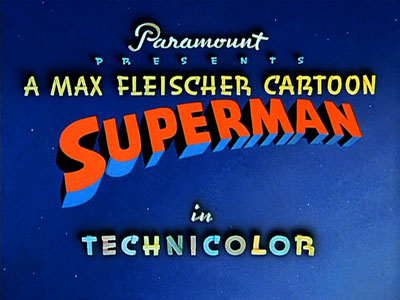We'll get back to stand-up comedians tomorrow. Here's my longtime pal Scott Shaw! on MeTV the other day…
FACT CHECK: Trump Speak at CPAC
![]()
Last Saturday, that president of ours spoke to the friendliest audience he could possibly have — at the Conservative Political Action Conference. Still, he said an awful lot of things that were demonstrably false. Daniel Dale goes down a long list of them.
Pantry Panic
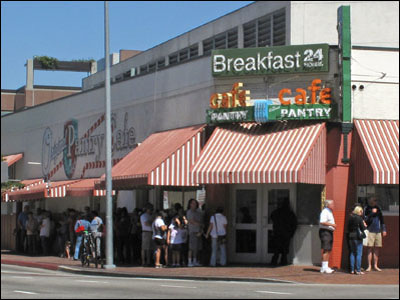
The Original Pantry, a landmark Los Angeles restaurant, is on the verge of maybe/possibly shutting down after operating in this city since When Dinosaurs Ruled the Earth. I mean the Age of Man, not the movie. It was (note the past tense) a wonderful 24/7 place to grab a steak or other very American entree and an especially great place for breakfast. That was true until a slow but an almost-tangible downslide began in 1980 when a gent named Richard Riordan purchased the place.
Mr. Riordan was the Mayor of Los Angeles from 1993 to 2001 and not, in my opinion, a particularly good one. That didn't matter much because the way Los Angeles is set up, the mayor has about as much power as one of those 25-cent batteries they used to sell at RadioShack — the kind you could put into your transistor radio and hear about half a song before you had to swap it out. We used to say, "His skill as a politician put him where he is today — in the restaurant business." He also ruined a great eatery called Gladstone's out by the ocean in Santa Monica.
Mayor Riordan was a nice man — I ate with him once and liked him despite Trumpian politics — but all his businesses suffered or shuttered. He passed away two years ago.
I'll tell you how great the Pantry was, once upon a time. You usually had to wait a long time to get in — and we did. And then once you were seated at a table, they immediately served you an unasked-for dish of cole slaw…and I still went there. The food was good, the food was cheap and the place was kind of legendary. It was open 24/7 and its owners, including the former mayor, bragged that they never, in all its seeming centuries of existence — actually since it opened in 1924 — were closed or without a customer.
Then COVID hit and they closed…and I think they did also once or twice to correct health code violations. Lately, they've been open not every day at every hour but Wednesdays through Sundays from 7 AM until 3 PM on weekdays and 5 PM on weekends. You'd think that if they could only turn a profit during those hours, someone would say, "Hmm…maybe we're doing something wrong."
So I don't go there anymore and neither do enough people for the place to be open at night. I feel bad for its employees, some of whom have been there since it was a great place to dine but I'm already seeing on the Internet, people who haven't eaten there for decades saying, "This is a landmark…we need to save it." And my thinking is that it's a little late for that. Someone should have begun applying corrective measures before it turned into a Denny's — and not a very good one.
Today's Second Video Link
A Ricky Gervais stand-up comedy special…
Scott Watch
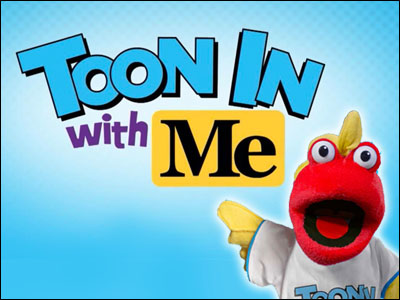
The cable/streaming channels MeTV and MeTV Toons run this cute li'l show called Toon In with Me hosted by Bill Leff and his finny friend, Toony the Tuna. They run classic cartoons and talk about cartoon history and on tomorrow's episode, the subject is the great animation director, Tex Avery. They will be joined in this by my longtime friend and co-conspirator, Scott Shaw!, who worked with Tex at Hanna-Barbera. You can tune in or you can toon in but don't miss it.
The schedule says it airs on MeTV at 7:00 AM on MeTV and 11:30 PM on MeTV Toons but with streaming channels, it's best to double-check what time things air in your area.
FACT CHECK: Condoms for Hamas
![]()
No, despite what Trump and Musk are saying, $50 million of government funds was not sent to Gaza to buy condoms for Hamas. The Associated Press people set the record straight.
Today's First Video Link
Last night on The Daily Show, Jon Stewart cut his hand when a breakaway (I guess) cup didn't breakaway (I suppose) as it was supposed to. This was not the first time Stewart has drawn blood with his comedy…
Missing Mike
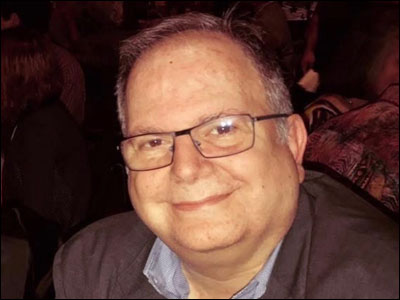
That's a photo of my pal Mike Schlesinger, who left us in early January and has been much-missed since then. He was a filmmaker and a very important person in the field of preserving motion pictures and their history. A lot of great movies might not exist today — or at least exist in good and complete prints — were it not for Mike. He was also a helluva nice guy.
On April 6, a bunch of us who miss him will converge on a movie theater in Santa Monica to miss him together. We'll talk about him and all he did…and then we're going to run his favorite movie (which also happens to be my favorite movie) the way we all feel it should be seen — on a big screen with a big, appreciative audience. If you knew Mike and/or want to help us celebrate who he was and all he did, click below for all the details.
FACT CHECK: Immigrants Voting
![]()
Elon Musk says — and a lot of Conservatives also say — President Joe Biden's immigration policy was "a giant voter importation scam." The folks at Politifact do a pretty good job of showing why that could not be the case.
ASK me: Game Show Writers

Dan Olson — who says he's from "definitely not the 51st state" — which I guessed right off meant Canada — wrote to ask…
As a reader of your blog & someone who loves going worm holing thru your archives, I know you are/were a fan of game shows. Having watched your friend Lorenzo Music and his wife Henrietta on an old Tattletales episode shown here in Canada this week, I was wondering about game show writers.
A show like Match Game (1973-79) publicized their staff writers (including MAD's Dick DeBartolo), with questions that could be suggestively sly or muddily mundane. Hollywood Squares had "quips" supplied to celebrities & the questions on T.T. occasionally seemed ripe for divorce court. I'm thinking even a show like Celebrity Sweepstakes (a personal favourite because it often appeared chaotic & near off-the-rails with some surly "Who booked me for this?!" stars) seemed like either there were jokes prepared (I seem to recall Pat McCormick on it). Was the role of a writer on these types of 60-70s shows a gateway to something bigger? Did you ever get an offer to do that?
Here's an easy answer: The role of a writer on a game show could be almost anything, especially on shows which did not come under the mantle of the Writers Guild of America, as many did and do not. Generally speaking though, they would write the questions and if the game involved celebrities coming up with funny answers or even real answers, the writers would supply them, though the celeb was free to make up his or her own funny or bluff response. The writers would also write out what the host was to say, though again what they gave the host might be treated more like a suggestion.
I have occasionally picked up a few bucks writing for game shows, mostly for run-throughs. A run-through is like a pilot that is not recorded. I was briefly involved in unsuccessful attempts to bring back, in quite a different form, the game show Rhyme and Reason and also Johnny Carson's old show, Who Do You Trust? Neither got past the runthrough stage. I turned down a few offers to write for shows which did get on the air but none of them interested me a lot…or maybe at all. It's probably just as well.
Webcam of the Week
Here's a live feed which, 24/7, shows you part of Times Square in New York. During most daylight hours, you can play a rousing game of "How Many Guys in Elmo Costumes Can I Spot?" The other day, I saw five, all cautiously keeping away from each other…
Today's Bonus Video Links
60 Minutes broadcast a profile this evening of John Oliver…
And here's the little extra segment they did just for the Internet…
Today's Video Link
Here's a John Mulaney special from some time ago. I linked to one excerpt from this before but it's worth watching again…
Political Stuff
Kevin Drum, apparently blogging from a hospital bed, presents a not-meant-to-be-complete list of ways in which Elon Musk is benefiting from the work he's doing, allegedly on behalf of the people of the United States. Looks like it's good for him and he doesn't care if it's good for us. Everyone who voted for Trump would be screaming if these things were being done by an unelected ally of President Kamala Harris.
Yes, I know I said I wasn't going to post a lot of this kind of thing but you knew I wouldn't be able to resist.
ASK me: Fleischer Supermans

Rob Morley wrote to ask…
I love the Superman cartoons that were produced by the Max Fleischer Studios (and later by Famous Studios) in the 1940s. I see a number of different DVDs and Blu-rays of them for sale and don't know which one to buy. Which one do you recommend?
Rob Morley is only one of many who have sent me this question and my answer is that I don't recommend any of them. I was going to get around to writing an explanation of why but I noticed that my pal Jerry Beck just wrote about this on Facebook. Jerry knows more about this kind of thing than I do, probably more than anyone. Here's what he had to say…
These films have never been properly restored — period. Some of the boneheaded decisions made by who ever has been in charge of remastering these for home video sale — not to defend them, but to help explain them — have been to "scotch tape" previous edits and screw ups instead of doing a proper search for master film elements.
It seems that when whoever syndicated them to television back in the 50s and 60s (apparently Motion Pictures For Television, Inc — the company that had the syndication rights for the George Reeves Superman TV show) cut the beginnings and ends (mainly to remove the Paramount logo) and replaced them with the origin (from the first cartoon) at the beginning, and the Famous ("mightier than a roaring hurricane," etc.) descriptor at the end. In doing so — they lopped off the sound track elements as well… so "whoever" at Warners simply replaced the silence with a "one size fits all" Paramount tag. George Feltenstein is dying to do the Superman cartoons — hopefully he'll get the chance soon…
George Feltenstein is a historian and producer for the Warner Archives and a gent with a stellar reputation among those who demand that classic films be properly restored and preserved. So I guess my recommendation is to wait until The Powers That Are permit George to produce a definitive set of those fine cartoons. I'm not sure if purchasing the flawed sets now makes that more likely or less likely. Whoever can commit the funds for someone like Mr. Feltenstein to work his magic might say, "Let's do it! There's obviously a lot of interest in these cartoons" or they might say, "There's no point in us doing that now. Everyone who cares about them has already bought them!"
They really are great cartoons, made back in the day when Superman was unique; when he was really the only hero in contemporary popular fiction who could fly, lift Chryslers, burst through brick walls, repel alien invaders, etc. Just in the world of DC Comics today — never mind Marvel and other outfits — there are now thousands of characters who can do all that. Once upon a time, he was special.
